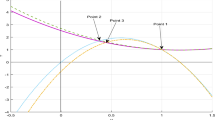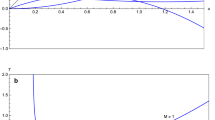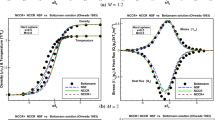Abstract
This paper investigates the structure of a normal shock wave using the continuum model for steady one-dimensional flow of a viscous non-ideal gas under heat conduction. The coefficients of viscosity and heat conductivity are assumed to be directly proportional to a power of the temperature. The simplified van der Waals equation of state for the non-ideal gas has been assumed in this work. The smooth and rough sphere models of the gas molecules in the kinetic theory of gases are used for the viscosity of a non-ideal gas. Assuming the Prandtl number to be 3 / 4, the complete integral of the energy equation, exact velocity, density, pressure, Mach number, change in entropy, viscous stress, and heat flux across the shock transition zone have been obtained in a perfect and a non-ideal gas under both constant and variable properties of the medium. The validity of the continuum hypothesis with respect to Mach number is examined for the study of shock wave structure in both the smooth and rough sphere models of ideal and non-ideal gas molecules. It has been shown that the continuum theory gives reasonably valid results for flows with higher Mach numbers in the case of a non-ideal gas in comparison with an ideal gas. The inverse thickness of the shock wave is calculated and compared for constant and variable properties of the gases. The shock wave thickness is also discussed as a function of mean free path of the gas molecules computed at different points between the boundary states. It is found that the inverse shock thickness decreases with the increase in non-idealness of the gas. In the rough sphere model of gas molecules, the increase in the non-idealness of the gas and the temperature exponent in the coefficients of viscosity and heat conductivity significantly increases the validity limit of the continuum model.









Similar content being viewed by others
References
Rankine, W.J.M.: On the thermodynamic theory of waves of finite longitudinal disturbances. Philos. Trans. R. Soc. Lond. 160, 277–288 (1870). https://doi.org/10.1098/rstl.1870.0015
Rayleigh, L.: Aerial plane waves of finite amplitude. Proc. R. Soc. Lond. A 84, 247–284 (1910). https://doi.org/10.1098/rspa.1910.0075
Taylor, G.I.: The conditions necessary for discontinuous motion in gases. Proc. R. Soc. Lond. A 84, 371–377 (1910). https://doi.org/10.1098/rspa.1910.0081
Becker, R.: Impact waves and detonation. Z. Phys. 8, 321 (1922) translation, NACA-TM-505 (1929). https://doi.org/10.1007/BF01329605
Thomas, L.H.: Note on Becker’s theory of the shock front. J. Chem. Phys. 12, 449–453 (1944). https://doi.org/10.1063/1.1723889
von Mises, R.: On the thickness of a steady shock wave. J. Aeronaut. Sci. 17, 551–554 (1950). https://doi.org/10.2514/8.1723
Morduchow, M., Libby, P.A.: On a complete solution of the one-dimensional flow equations of viscous, heat conducting, compressible gas. J. Aeronaut. Sci. 16, 674–684 (1949). https://doi.org/10.2514/8.11882
Meyerhoff, L.: An extension of the theory of the one-dimensional shock waves structure. J. Aeronaut. Sci. 17, 775–786 (1950). https://doi.org/10.2514/8.1806
Gilbarg, D., Paolucci, D.: Structure of shock waves in the continuum theory of fluids. J. Ration. Mech. Anal. 2(4), 617–642 (1953). http://www.jstor.org/stable/24900350
Chapman, S., Cowling, T.: The Mathematical Theory of Non-uniform Gases. Cambridge University Press, Cambringe (1970)
Cercignani, C.: Theory and Application of the Boltzmann Equation. Scottish Academic, Edinburgh (1975)
Ferziger, J.H., Kaper, H.G.: Mathematical Theory of Transport Processes in Gases. North-Holland, Amsterdam (1972)
Bobylev, A.V.: The Chapman–Enskog and Grad methods for solving the Boltzmann equation. Sov. Phys. Dokl. 27, 29 (1982)
Struchtrup, H.: Failures of the Burnett and super-Burnett equations in steady state processes. Contin. Mech. Thermodyn. 17, 43–50 (2005). https://doi.org/10.1007/s00161-004-0186-0
Torrilhon, M., Struchtrup, H.: Regularized 13-moment-equations: shock structure calculations and comparison to Burnett models. J. Fluid Mech. 513, 171–198 (2004). https://doi.org/10.1017/S0022112004009917
Sakurai, A.: A note on Mott-Smith’s solution of the Boltzmann equation for a shock wave. Fluid Mech. 3, 255–260 (1957). https://doi.org/10.1017/S0022112057000622
Sakurai, A.: A note on Mott-Smith’s solution of the Boltzmann equation for a shock wave, II. Research Report, vol. 6, p. 49. Tokyo Electrical Engineering College, Tokyo (1958)
Mott-Smith, H.M.: Solution of the Boltzmann equation of a shock wave. Phys. Rev. 82(6), 885–892 (1951). https://doi.org/10.1103/PhysRev.82.885
Talbot, L., Sherman, F.S.: Experiment versus kinetic theory for rarefied gases. In: Devienne, F.M. (ed.) Proceedings of the 1st International Symposium on Rarefied Gas Dynamics. Pergamon, New York (1960)
Bird, G.A.: Proceedings of the 7th International Symposium on Rarefied Gas Dynamics, vol. 2, p. 693 (1971)
Hicks, B.L., Yen, S.M., Reilly, B.J.: The internal structure of shock wave. J. Fluid Mech. 53, 85–111 (1972). https://doi.org/10.1017/S0022112072000059
Wang Chang, C.S.: On the Theory of the Thickness of Weak Shock Waves. Department of Engineering Research, University of Michigan, APL/JHU CM-503, UMH-3-F (1948)
Zoller, K.: Zur struktur des verdiehrungsstobes. Z. Angew. Phys. 130, 1–38 (1951)
Grad, H.: Profile of a steady plane shock wave. Commun. Pure Appl. Math. 5(3), 257–300 (1952). https://doi.org/10.1002/cpa.3160050304
Struchtrup, H., Torrilhon, M.: Regularized of Grad’s 13-moment equation: Derivation and linear analysis. Phys. Fluids 15, 2668–2680 (2003). https://doi.org/10.1063/1.1597472
Khidr, M.A., Mahmoud, M.A.A.: The shock-wave structure for arbitrary Prandtl number and high Mach numbers. Astrophys. Space Sci. 113, 289–301 (1985). https://doi.org/10.1007/BF00650964
Johnson, B.M.: Analytical shock solutions at large and small Prandtl number. J. Fluid Mech. 726(R4), 1–12 (2013). https://doi.org/10.1017/jfm.2013.262
Myong, R.S.: Analytical solutions of shock structure thickness and asymmetry in Navier -Stokes/Fourier framework. AIAA J. 52(5), 1075–1080 (2014). https://doi.org/10.2514/1.J052583
Bird, G.A.: Molecular Gas Dynamics and the Direct Simulation of Gas Flows, 2nd edn. Clarendon Press, Oxford (1994)
Anand, A.K., Yadav, H.C.: On the structure of MHD shock waves in a viscous non-ideal gas. Theor. Comput. Fluid Dyn. 28, 369–376 (2014). https://doi.org/10.1007/s00162-014-0320-y
Anand, A.K., Yadav, H.C.: The effect of viscosity on the structure of shock waves in a non-ideal gas. Acta Phys. Pol. A 129, 28–34 (2016). https://doi.org/10.12693/APhysPolA.129.28
Wu, C.C., Roberts, P.H.: Shock-wave propagation in a sonoluminescing gas bubble. Phys. Rev. Lett. 70(22), 3424–3427 (1993). https://doi.org/10.1103/PhysRevLett.70.3424
Roberts, P.H., Wu, C.C.: Structure and stability of a spherical implosion. Phys. Lett. 213, 59–64 (1996). https://doi.org/10.1016/0375-9601(96)00082-5
Vishwakarma, J.P., Chaube, V., Ptel, A.: Self-similar solution of a shock propagation in a non-ideal gas. Int. J. Appl. Mech. Eng. 12, 813–829 (2007)
Vishwakarma, J.P., Mahendra, S.: Self-similar cylindrical ionizing shock waves in a non-ideal gas with radiation heat-flux. Appl. Math. 2(1), 1–7 (2012). https://doi.org/10.5923/j.am.20120201.01
Nath, G., Vishwakarma, J.P.: Similarity solution for the flow behind a shock wave in a non-ideal gas with heat conduction and radiation heat-flux in magnetogasdynamics. Commun. Nonlinear Sci. Numer. Simul. 19, 1347–1365 (2014). https://doi.org/10.1016/j.cnsns.2013.09.009
Landau, L.D., Lifshitz, E.M.: Statistical Physics, Course of Theoretical Physics, vol. 5. Pergamon, Oxford (1958)
Bird, G.A.: Definition of mean free path for real gases. Phys. Fluids 26(11), 3222–3223 (1983). https://doi.org/10.1063/1.864095
Acknowledgements
Arvind Patel expresses thanks to the University of Delhi, Delhi, India, for the R&D Grant vide letter no. RC/2015/9677 dated October 15, 2015. The research of the Manoj Singh is supported by UGC, New Delhi, India, vide letter no. Sch. No. /JRF/AA/139/F-297/2012-13 dated January 22, 2013. The authors would like to present their sincere thanks to the referees and editor for their valuable comments on the original manuscript, which were quite helpful to revise the paper in the present form.
Author information
Authors and Affiliations
Corresponding author
Ethics declarations
Conflict of interest
The authors declare that they have no conflict of interest.
Additional information
Communicated by A. Higgins.
Publisher's Note
Springer Nature remains neutral with regard to jurisdictional claims in published maps and institutional affiliations.
Rights and permissions
About this article
Cite this article
Patel, A., Singh, M. Exact solution of shock wave structure in a non-ideal gas under constant and variable coefficient of viscosity and heat conductivity. Shock Waves 29, 427–439 (2019). https://doi.org/10.1007/s00193-018-0855-8
Received:
Revised:
Accepted:
Published:
Issue Date:
DOI: https://doi.org/10.1007/s00193-018-0855-8




